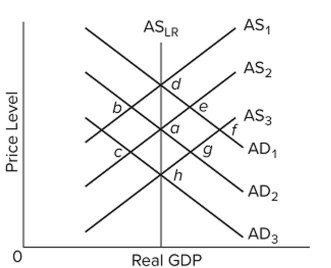Multiple Choice

Refer to the figure and assume the economy initially is in equilibrium at point a. In the new classical theory, an unanticipated increase in aggregate demand from AD2 to AD1 would move the economy
A) directly from a to d.
B) from a to b to d.
C) from a to e to d.
D) directly from a to f.
Correct Answer:

Verified
Correct Answer:
Verified
Q267: The real-business-cycle theory holds that business fluctuations
Q268: According to economist Milton Friedman, a major
Q269: Mainstream economists favor<br>A) the use of discretionary
Q270: Monetarists and rational expectations theorists both favor
Q271: If nominal GDP is $848 billion and
Q273: Which of the following ideas of the
Q274: New classical economics suggests that in the
Q275: The equation of exchange suggests that, if
Q276: According to real-business-cycle theory, recessions are caused
Q277: Does velocity change in response to changes